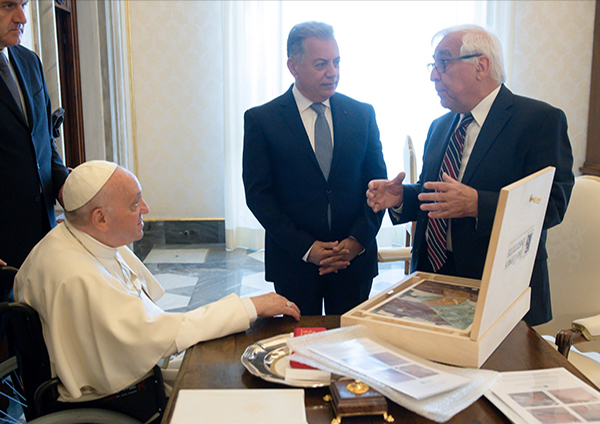APAC Labs research and expertise the study, promotion and preservation of Cypriot historic graffiti contributed the creation of a unique and meaningful gift that was offered to Pope Francis during the recent visit of CyI president in Rome.
The gift consisted of an exact replica of a detail from the 14th century wall paintings in the catacomb of Saint Solomoni in Paphos. The fresco detail from the 14th century wall paintings in the catacomb of Saint Solomoni in Paphos, Cyprus provides material testimony to the centuries-long role of the island as a Mediterranean hub of Christian pilgrimage and cultural interconnection. Moreover, this detail of the preserved fresco decoration bears the syncretic written evidence of the passage of pilgrims and migrants through the sacred underground site in the city of Paphos, linked with the Apostolic journey of Saint Paul and Saint Barnabas.
The particular detail depicts the hand of a Church Father holding an opened scroll. Devotional graffiti in Greek, Armenian and Latin, tentatively dated in the 15th-17th centuries, were incised directly on the fresco surface. The graffiti testify the passage of pilgrims and migrants and underline the long continuity of the cult and the diachronic role of Cyprus as a place of pilgrimage and migration at the crossroads of the Mediterranean, a theme that was underscored by Pope Francis himself during his last visit to the island.
Building on the 2D and 3D digital imaging of the catacomb and its frescoes by the Cyprus Institute and the APAC Labs of the Science and Technology in Archaeology and Culture Research Center (STARC), which was led by graffiti heritage expert Dr. Mia Trentin, the exact copy of the fresco details from Saint Solomoni was realized with the collaboration of Dr. Iosif Hadjikyriakos, painter and art historian.
The making process followed the traditional Byzantine technique of fresco painting, using natural and local materials, both for the plaster and the pigments. The plaster was applied in three different layers in a pinewood box. The preparatory sketch was made directly on the plaster with a round brush using local terra d’ombra while the colours were applied with hand-made brushes. The pigments are made of natural oxides mixed with natural glues.
Finally, detailed digital images supported the precise reproduction of the original incised graffiti, which testify the passage of pilgrims and migrants from the holy site. Centuries later, the island of Cyprus continues to be a destination and a safe haven for migrants seeking refuge, help and spiritual guidance on its hospitable coasts and beaches. The preservation of this fragile yet invaluable heritage with the help of Science and Technology at the Cyprus Institute is of utmost importance in our changing and volatile world.
